Emma Porteous Interview
Interview by David Richardson
TV Zone Number 9, Supervillains Special (June 1993); p9-13
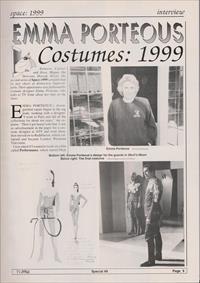
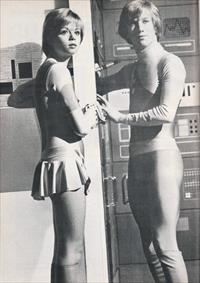
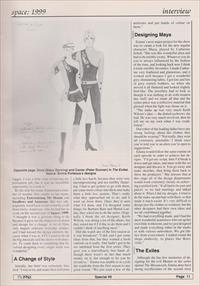
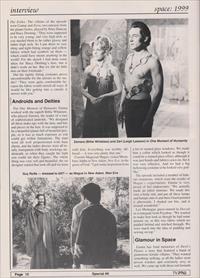
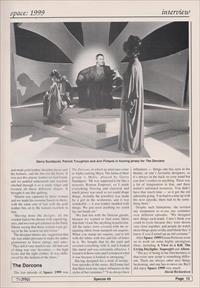
Zamara, Cantar and Zova, Magus, the Dorcons, Dorzak, Elizia; the second series of Space: 1999 certainly had its fair share of distinctive Supervillains. Their appearance was fashioned by costume designer Emma Porteous, who talks to TV Zone about her time on the show.
Emma Porteous's distinguished career began in the rag trade, working with a designer. "I went to Paris and did all the collections for about ten years," she explains. "Then I got bored with that. I saw an advertisement in the paper for a costume designer at ATV and went there, then moved on to Rediffusion, which collapsed and became London Weekend Television.
I was asked if I wanted to work on a film called Performance, which starred Mick Jagger. I was a little wary of leaving my permanent job. hut it was an incredible opportunity so I took it"
By the mid-Seventies Emma had a number of notable film credits to her name, including Entertaining Mr Sloane and Swallows and Amazons. She subsequently lured back to television by a call from Gerry Anderson, who invited her to work on the second series of Space: 1999. "I thought it was a glorious thing to do because it gave me the chance to sit and design for a chance. A lot of films only require ordinary everyday clothes, and I had missed the design element, because when I was at ATV I used to do all the big musicals and the shows with dancers. To come back to something that in designing every single week was wonderful."
Initially, her brief was extremely limited; "I was to try and make their uniforms a little less harsh, because they were very uncompromising and not terribly flattering. I had to get jackets to go with them, put some more colour into them and make them a little less austere. That's really what they approached me to do, and it went on from there. Once they'd seen what I'd done, and I'd designed some things for Barbara Bain and Martin Landau, they asked me to do the series. Originally I think the set designer, Keith Wilson, was doing a lot of the aliens, but they asked me if I'd like to do them and I couldn't think of anything nicer."
Did she watch any of the first season as it was broadcast? "I did, and I got some ideas from that, but they wanted a fresh outlook on it really. One hadn't got to be too inhibited from the first series. They gave you a marvellously free hand, although there wasn't in fact that much money on it, but enough to let you be inventive." Emma was unable to re-cycle the wardrobe from the first season to any great extent: "We just used a few of the uniforms and put bands of colour on them."
Emma's next major project for the show was to create a look for the new regular character Maya, played by Catherine Schell. "She was this wonderful alien and had to be terribly exotic. Whatever you do you're always influenced by the fashion of the time, and looking back now I think it looks terribly Seventies. I made Catherine very feathered and glamorous, and it worked well because I got a wonderful grey shimmering fabric. I got lots and lots of grey ostrich feathers, so when she moved it all fluttered and looked slightly bird-like. The jewellery had to look as though it was nothing to do with modern day stuff, and we made all that and the centre piece was a reflective material that glowed when the light was shone on it.
"The make up was very much Keith Wilson's idea - the dotted eyebrows she had. He was very much involved, then he left me on my own when I was established." Did either of the leading ladies have any strong feelings about the clothes they should be wearing? "Not really, they were all extremely amenable. I think once you're told you're an alien you're open to suggestions."
Emma would follow the same routine on each episode in order to achieve her designs. "I'd get my script, then I'd break it down and get ideas, and meet with the set designer and discuss it. You go away and make sketches, then bring them back to show the producers." She stresses that at this stage all of the design departments would work extremely closely on achieving a unified look: "It all had to be part and parcel, so we had meetings and talked about it. When I did my designs, I tried to do the make-up and hair with them, so that made it much easier. It's very difficult to design just the clothes in isolation, but the other designers had their own ideas and we all contributed together.
"We had everything made, and I had the most wonderful seamstress who set up her own little workroom, and we just designed and made everything either in the studio or with various outworkers. We got fabrics from everywhere; I trailed round the shops endlessly, to places like Borovicks." [Borovick Fabrics in Soho]
Although she has few memories of designing for the evil Mentor in the series opener The Metamorph, Emma does have strong recollections of the second story The Exiles. The villains of the episode were Cantar and Zova, two outcasts from the planet Golos, played by Peter Duncan and Stacy Dorning. "They were supposed to be very young, and very high tech, so you needed them to be rather glossy and rather high tech. So I put them in very shiny and tight-fitting orange and yellow fabrics which had symbols on them which could have meant anything in the world! For the sketch I had done some ideas for Stacy Dorning's hair, but it didn't work on her. But we did do little dots on their foreheads."
Did the tightly fitting costumes prove uncomfortable for the artistes in the studio? "They were quite comfortable because the fabric would stretch all ways. It would be like getting into a catsuit; it moves with you."
For One Moment of Humanity Emma worked with the superb Billie Whitelaw, who played Zamara, the leader of a race of sophisticated androids. "We designed all these make-ups with the dots, and bits and pieces in the hair. It was supposed to be a beautiful planet full of beautiful people, so it was as much exposure as you could get within limitations. The men were all well proportioned with bare chests, and the ladies dresses were all totally transparent with body stockings underneath, so when they caught the light you could see their figures. The whole thing was very soft and beautiful; the set designer started that look off and we went with him. Everything was terribly diffused - it was very pretty that one."
Cosmic Magician Magus visited Moonbase Alpha in New Adam, New Eve, in the guise of God. "I got some inspiration from a lot of stained glass windows. We made him a collar which looked as though it could be a stained glass effect, although it was just braids and fabrics sewn on, but it was very effective. And we had a big bellowing costume so he looked very godlike."
The episode included a number of hideous mutations, which were the results of Magus's experiments. Emma is very proud of her endeavours: "We actually made an entire monster. We made this man a body suit, and put all these lumps and bumps onto it and then I hand painted it afterwards. I shaded out bits, and it looked wonderful."
Lee Montague guest-starred in Dorzak as a renegade from Psychon. "We wanted to make him look as though he had some armour on, so this was fabric which we padded behind and stitched through. We were much into the idea of padding and sewing on top."
Emma has fond memories of Devil's Planet, a story that featured a band of glamorous female villains. "They wanted something striking, as all the ladies were prison warders and extremely sexy as well. We came up with these red leotards and made gold leather shoulder pieces and the helmets, and the bits for the boots. It was just this plastic leather we had found, and we padded underneath and machine stitched through it so it made ridges and formed all these different shapes. It brought it out like quilting.
"Martin was captured by these women and we made his costume based on theirs, with the same sort of feel with the gold leather bits on it. He looked excellent in that.
"Having done the designs, all the women had to be chosen with superb figures, and we even got a feature in the Daily Mirror saying that these women were going to be the sexiest on television." The designer denies any suggestion that she was under pressure to make the ladies glamorous to boost ratings and sales: "They left it very much to me. All that sort of thing was very Seventies - the high boots and the tight clothes. It was influenced by the fashion of the times."
The last episode. of Space: 1999 was The Dorcons, in which an alien race come to Alpha seeking Maya. The Judas of their group is Malic, played by Gerry Sundquist; "He was supposed to be like a neurotic Roman Emperor, so I made everything flowing and classical and much jersey was used so we could drape things. Actually the jewellery was made by a girl in the workroom, and it was wonderful - it was leather studded with things. We just used anything we could lay our hands on."
"We had fun with the Dorcon guards, because we wanted to find some fabric that didn't look like anything in particular. All the tunics were covered with the remaining fabric from stamped-out sequins. When you stamp out sequins, you're left with the fabric with lots and lots of holes in it. We bought that by the yard and covered everything with it, and it looked like metal and was extremely effective. I found it in Borovicks and I wondered what it was because it looked so intriguing."
Having designed for a total of twenty-four episodes of the series, did Emma feel that there were any major influences in the styles of her costumes? "You always have influences, things one has seen in the theatre, or one's favourite designers, so it's always in the back on your mind but you don't confess to anything. There was a lot of imagination in that, and there weren't unlimited resources. You didn't have that much time so it got the old adrenalin going. You had to come up with the next episode, there had to be something there."
Despite such limitations, she resisted any temptation to re-use any costumes over different episodes. "We designed new things each week. I don't think you could re-cycle because they were shown very close together, and people do watch those things quite avidly and I think they'd know if you'd tarted up an old costume."
After Space: 1999 Emma Porteous went on to work on some highly prestigious films, including A View to a Kill, The Living Daylights, Supergirl and Aliens. "The joy of being in the film business is that every new script is something different. There are always other nice things beckoning, and one has to move on. But I did enjoy Space: 1999 very much.
David Richardson